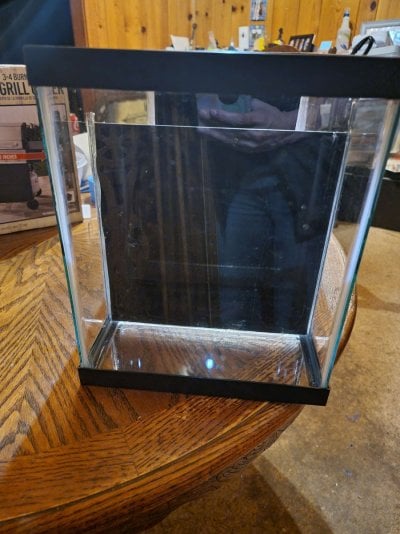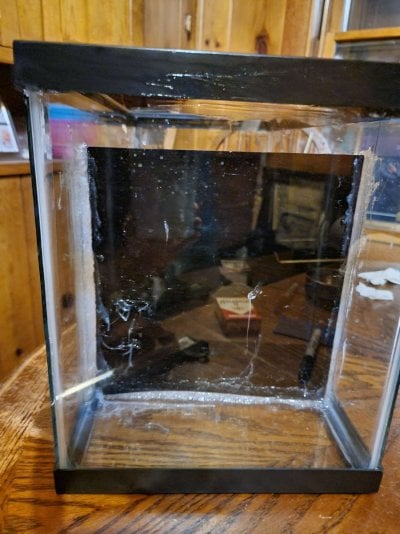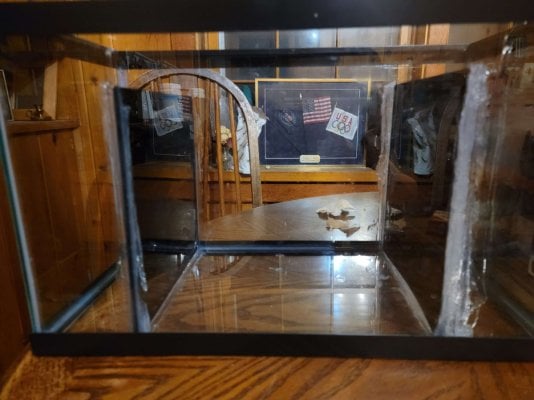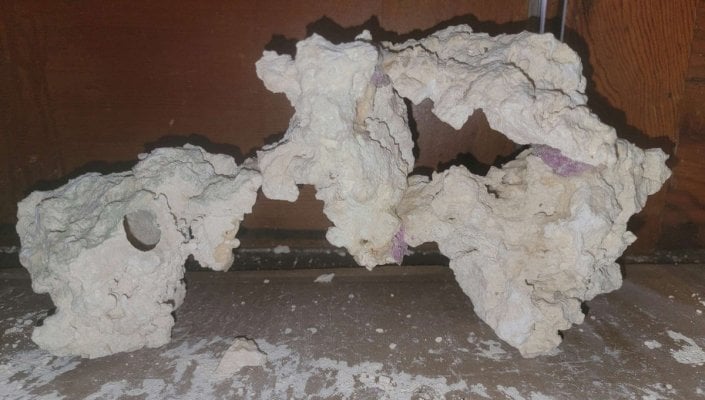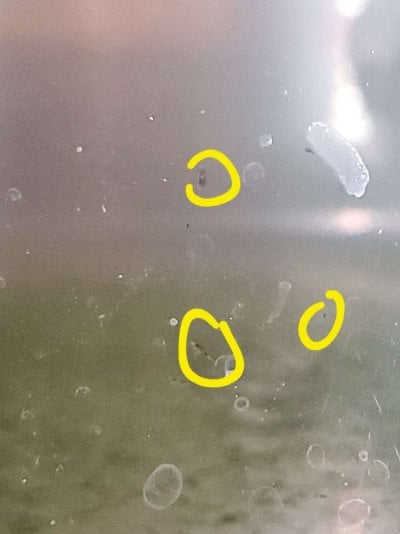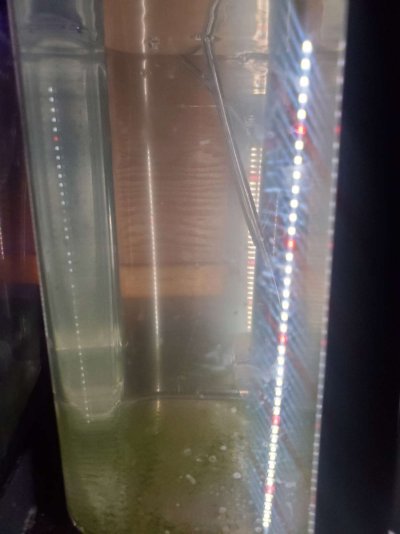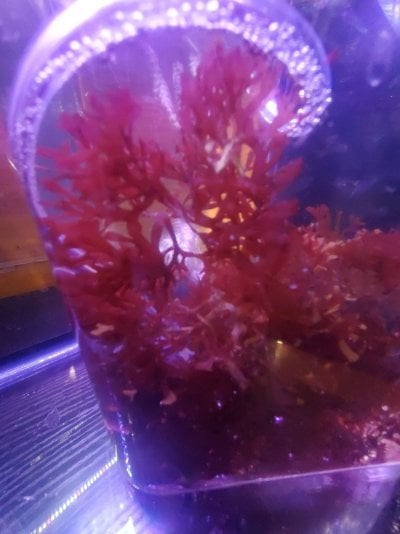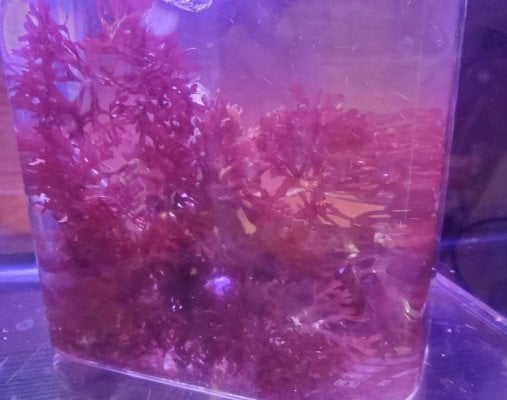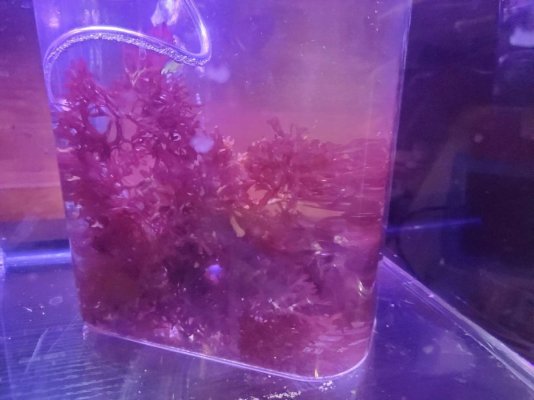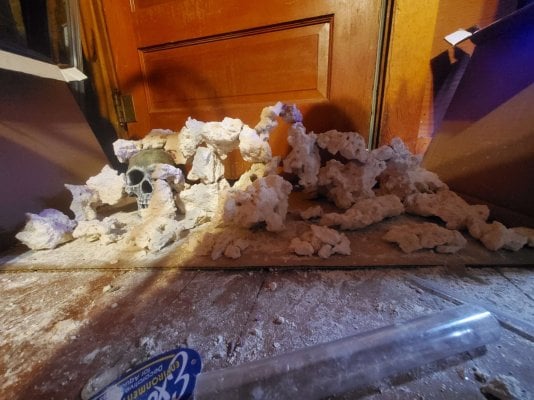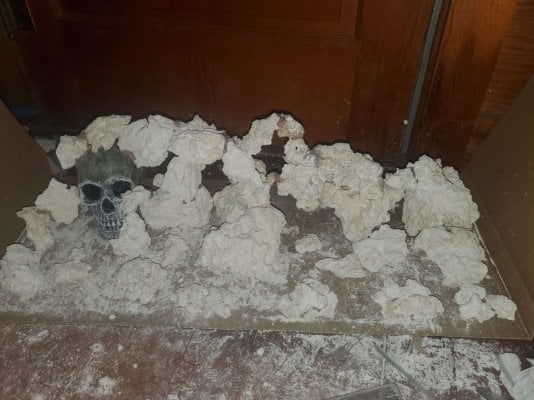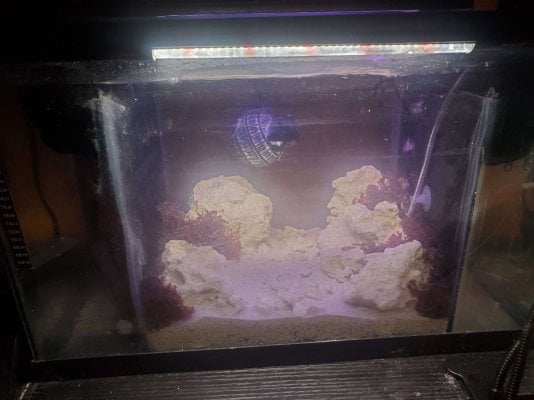Note from future me... I know this is long, and I am really sorry for anyone that reads it fully. It is a pretty lengthy post and may ramble a lot, as I haven't had time to edit it all. Eventually, I do plan on making a TL;DR portion near the top here with the basic bullets of information for quicker reference, though for now, this is what it is.
This is still in the planning/buying process, so I don't have many pictures yet, though I wanted to do this to keep my head organized and give a place for people who know what they are doing to help correct me if needed. I've been planning this tank for over a year and slowly collecting pieces to get a good setup with quarantine tanks. I have zero experience in saltwater and/or reef tanks, though I have little expertise in keeping freshwater-planted aquariums many years ago. So any advice will be appreciated. I have been watching tons of BRS videos and doing a lot of research, so I am not entirely uninformed about what I am doing.
I will eventually add a few pictures in the next post with sort of some basic ideas, pictures, and diagrams. As well as hopefully an update on the drilling for the overflow and the sump setup.
Design Ideas
For the base design idea, I am going with a toxic/death/wasteland that nature/coral is taking back sort of theme. I have various-sized skull aquarium decor that I plan on placing around and in the rockwork. They will work as structural pieces that guarantee suitable little dark hiding holes inside the rock for the fish to hide/destress, but I do want them to peak out, so it looks like the rockwork is just beginning to work its way over the dead. Then I plan to fill a few small glass bottles with highlighter water meant to look like glowing toxic waste under the blue reef lights I plan to secure along the rockwork and sandbed. I have like 4 different highlight colors that will fill up about 12 small bottles (blue, green, purple, and pink). For these, I will seal them with a good amount of silicone at the top to keep the highlighter water in, though I plan to put them in a tub of saltwater for a month to ensure they don't leak before actually putting them in the tank.
As for the rockwork, I want it to be a series of shelves that go up to a point near the mid-back corner of the tank but lean slightly off-center towards the left. I plan to keep it 1-2 inches away from the rear glass and have several arches and holes to help keep the flow moving around the structure better. Though I am placing the tank in my house, it would give me the best viewing option from the front right corner, where my desk sits (I work from home). So that is the view I will cater to the most, but I do want most of the front and sides to be pretty open as well, so things closest to the front and sides will be closer to the sandbed and working their way up to help optimize viewing.
As for the refugium, I want to decorate it like an overgrown trail, with planted algae along the edges pushing in and choking out the path. I am putting sand at the bottom of my refugium and using a bit of rock rubble to give the algae some added height, with the smallest rock rubble along the sandbed making up a "cobblestone" walking path. Having that twilight on a scary path type feel with the more red refugium lights. I still have to get a few more decor pieces, but I wanted to get some tiny benches and a little town decor items that give it more of that feeling of a once-populated walking path that is now deserted (well, of people).
The theme is why I want to name the tanks "Killer Cove" and give all the fishies names from horror movies. Like the clownfish, I was thinking of going with Pennywise and Krusty, Chucky and Tiffany for the dragonettes; if I get a goby, I was thinking of naming the Sandman and the pistol shrimp Freddy—that type of idea and giving a fun little twist to things.
Anyways, I want most of the design idea to be something that sort of adapts over time, as the tank progresses. I see the design idea as something more living a story, than as a picture in time. I sort of want to embrace each stage of the reefing process with a little hypothetical storyline as nature takes over and claims the space. So I design plan will change as various corals and things start to grow and various things start to cohabitate in the little ecosystem.
Plan
The display will be a 20G long tank but be upgraded into a 30G once things are more established and the fish start getting into their adult sizes. The sump is a 10G that I plan to separate into 4 sections—a 2.5G section where the overflow water will enter the refugium and houses my mechanical filtration, a 5G middle section that will house the refugium area, and another 2.5G section that will split down the middle to house the heaters/return pump. With the dividers, I plan on drilling holes that are meant to allow water through at set heights (the top 1/3 about), allowing, for whatever reason (like a clogged overflow), that the return pump area is the only one that can run completely dry, saving my heaters and refugium.
As for filtration, I actually don't plan on using any mechanical filtration. Though I plan to leave enough room in the sump to place a few of the smaller filter socks just in case, I hope that most of the larger debris will settle to the bottom of the overflow part of the sump and that I can vacuum that out weekly. I am doing this because I don't want to kill the copepod population by removing too much at a time with mechanical filtration, so I figured, at least early on, I would give them a chance to establish themselves and see what the refugium can handle on its own. Later I can figure out whether I would like to polish my water more. I have quite a few bio-balls and some of those bags that help contain them, which I plan to place around the sump to increase the biofiltration surface area where I can hide them.
As for rock and startup, I plan on mainly using dry white rock. I chose this primarily for aesthetics, as I think the white of the skulls and stuff would make the white rock look alright together. As well as giving the impression like the area was "toxically bleached" and finally recovered when the coralline algae finally took hold and started covering the rock and the skulls together. I know this could cause a few issues early on, as it has less biodiversity and whatnot. However, I plan on adding Microbactor 9 to help start the bacteria cycle in the beginning, as well as getting a little bit of live rock from my local aquarium into a dark part of my sump to help seed this process a little faster and hopefully fix this. Though otherwise, I am prepared to be patient for the most part, give it time, and add different varieties of bacteria later.
I have about 30 lbs of dry rock right now that I plan to use between the display and the refugium that I plan on mostly breaking into pieces and putting back together with epoxy, glue, and aquascaping cement into the desired shapes. This is where the skulls and other various structural things will help keep things from falling apart on me . I also have a few acrylic rods that I plan on using to help make shelves, archways, and flow holes a little more structurally sound. Ultimately, the plan is to have the primary display rock one large piece that I can effectively move when I upgrade to the larger tank when it's time. The goal is to use most of the dry rock in the display tank and the leftover pieces to make up the refugium. Though, I might get a little bit more to fill in, depending on what I am left with.
. I also have a few acrylic rods that I plan on using to help make shelves, archways, and flow holes a little more structurally sound. Ultimately, the plan is to have the primary display rock one large piece that I can effectively move when I upgrade to the larger tank when it's time. The goal is to use most of the dry rock in the display tank and the leftover pieces to make up the refugium. Though, I might get a little bit more to fill in, depending on what I am left with.
Side note: I also plan on setting up some blackout curtains that wrap nicely around both tanks separately. Since my display and my refugium, I am planning on having opposite lighting cycles, one for the pH stability, and two so that the refugium can be the star at night, I didn't want too much light spillage causing unwanted algae growth in weird spots. So to combat this I plan on cutting up and hemming a few blackout curtains, and sewing some magnets into the hems. Then take a few extra magnets and supergluing them to the sides of the tank at various spots. This way I could easily snap the curtains around either tank or open and close each one to various degrees. This I think will help me hide the overflow/filter/return areas on the refugium when I am not doing maintenance on them, but still keep the pretty accessible when I am. Let alone I think it will help maintain tank temps better (aka less work on my heaters) since where I live it gets pretty cold in the winters. Lastly, though, I think it will give me a way to nicely hide some tubing and cords in the back without being too conspicuous.
Stocking Plans
Livestock-wise, I plan on keeping the tank simple and adding 1-2 fish every few months (or longer) until I have it stocked. I am first adding a clownfish pair, mostly likely a designer kind, though I haven't decided yet between snowflake or darwin. I am then adding a few cleanup crew members as needed, primarily snails and hermit crabs, though I might get a fish later if my algae from the refugium could support it. Once the copepod/brine shrimp/etc population gets high enough, I would look into a pair of dragonettes, most likely yellow mandarins. Eventually, once the sandbed seems established enough and seeing what I would need to supplement, adding a watchman goby with a pistol shrimp. If all that doesn't work out, I have other ideas for a few easier fish to replace the more challenging fish, though this is what I am planning for now.
Corals, I am not sure what I will be getting fully yet. The only thing I know is I want them to go with the theme and be pretty fluorescent. Giving off the idea that they absorbed some of that toxic waste or something. I think this will come together a little more once the tank is up and running, and I can test the PAR levels around the tank. I plan on having a good mix of different SPS and LPS corals in the end and would like a nice piece to be the central part of the rockwork, but I plan on starting with some easier/cheaper corals. I have a few small garden rocks that will be away from the main rock structure, and I plan on starting with some zoanthids and GSP on these until I decide what I want later. However, things like leather corals, frogspawn-type euphyllia, mushrooms, bird nests, and various others have been where I've been drawn.
Foodwise, I am hoping to create an environment that could sustain itself for the most part. Still, this is more of a process than a destination, especially after adding the dragonettes and goby, as they might kill off the established populations (I'm not sure). To start, I plan on culturing some copepods, brine shrimp, and phytoplankton in plastic containers that will be added into the tanks regularly to allow a decent population to take hold. But eventually, I would like to cut back on this if I can and have the refugium naturally do most of the work to keep the numbers high enough in the display tank. As I go for this, though, I will have to see and likely monitor after adding new fish or corals. Also, I plan on growing things like sea lettuce and pompom gracilaria as my refugium algae. In the design, I plan on having various rock rubble switched back and forth between the refugium and the display to keep the cleanup crew fed and the algae pruned, though some might change depending on what and how much is consumed by the tank.
At first, I know this probably won't be enough to sustain anything. I also know that I need phosphates and nitrogen in the water column, at least a little for the refugium algae, so this is why I plan on starting off feeding twice a day for the first month or so and monitoring things daily to adjust as needed. The idea of 5-10 pellets per fish in the morning and 1/4 of a frozen cube each night sounds reasonable until I can understand what my tank is producing at that level to adjust from there.
Corals I do not initially plan on feeding. I sort of what to see how they do with filter feeding from the tank and just doing my best to maintain various aspects like alkalinity, calcium, or magnesium and get that tuned in first. Since I have no idea what any of that takes, I plan to monitor it weekly before and after my water changes and figure out what I need to add manually. I also probably will quickly start figuring out some amino acids and fertilizers to add for the corals/refugium and trace elements. However, I plan to get my mind around the alkalinity and major elements first, then figure out what is missing from the more trace elements and whatnot. Though in the future, I would enjoy a few that benefit from target feeding occasionally.
Equipment
Lighting - I have two Fluval Sea Marine 3.0 LEDs. One is 15-24 inches to fit over the sump, and one is 24-34 inches to fit the display tank nicely. I got them as a pair for a discount, which is why I plan to use a marine light in the refugium (at first). They do have apps that allow me to set color variations, so for now; I am planning more blue/cyan lighting for about 8 hours (6 full strength) during the day for the display, and for the night, more red/white lighting for the refugium for about 12 hours (10 full power). However, these might get replaced depending on the PAR after the tank is set up. The refugium lights are the first ones I plan on replacing. I plan to eventually move the smaller marine light to the Coral Quarantine and get a more refugium-specific light here.
Overflow - I am using the Two Little Fishies Xaqua InOut Overflow and Return, along with their hose kit made for it. I'll be honest; their hose kit seems a little overpriced for what it is, though I got it for the peace of mind that it would all fit together nicely when I was ready to do that. Since I just got the very basic aquarium tank from Petco (with glass lid cover), I also had to buy a diamond hole saw set cause this overflow didn't come with it, but that is also beside the point. I found a decent set for various small to larger sizes for not too much more, and I can use it for things like drilling holes in glass for my copepod cultures and things of that nature.
Return Pump - For this, I am using the Quiet One PRO-1200 Pump (317 GPH), and I hope this is enough to turn the tank over enough times (it's 30 gallons in total, so this would turn that over in a little over 10 times each hour) when performing optimally. For now, I have two backups that pump 240 GPH of the same brand, just in case the cheaper pump breaks faster than I anticipated. Though only time will tell. I hope to have at least a year before I have to replace this at the very least.
Monitoring Device - I have gotten the Seneye Reef Aquarium Monitor (V2), which, since the tank will be close to my computer, I can hardwire for constant updates on at least the important stuff and give me a better idea of where the basics are sitting without having to test 5 times a day. This also has a basic PAR meter, and I plan to get at least a basic idea of what PAR is around the tank and at various heights. TBH, this was the main reason I got it, as PAR meters can be expensive, and I figured the extra testing was beneficial. I haven't used it yet to know how accurate it is, though.
Powerheads - I have 6 various different powerheads and wavemakers that are decently cheap. 3 of them are AQQA 3W 530GPH with what I think to be a decently wide flow and 3 Freesea 1050GPH that have more of a narrow flow. so I ended up getting a few power strips that will be hooked up to some simple timers to help give various flow rates throughout the day. Down the road, I would like to eventually replace these with nicer powerheads that can do this with fewer powerheads to do the same thing, but for the price, they were a little out of the budget for yet, with the ones that I was looking at being closer to $400 per. So these will probably be one of the last things I actually replace.
Heaters - I am using the Aqueon PRO-150 heaters. I plan on eventually getting a 2nd one as the backup, but for the first few months, I'm going to rock with the one and see what temp it is able to keep easily. I also have 2 Fluval M50 50W that I plan to use in the two separate quarantine tanks. Right now I have zero ideas about which one works better, though the Fluval ones seem like an easier design to hide, but I was unable to find large enough ones for the 30G between the display and refugium. It is also really cold where I am, especially in the winter, and this is why I went a little higher on the W recommendation for the heaters.
Algae Barn - As for the algae and the copepods/phytoplankton/brine shrimp, I plan on getting most of that from the algae barn. I find BRS to be the most cost-effective way, though actually for what I wanted it was cheaper to piece it together than getting the refugium startup kit. This is because I do want to start off with Algae Barn Galaxy Pods since they have the most diversity, as well as two different algae. The Galaxy Pods I plan on breeding in a culture to help really get the numbers established, though I may plan to switch types later to more specific types that are being consumed the most as time goes on. I also plan on getting Algae Barn Nano Brine Shrimp to culture and keep going in the water column, as well as Algae Barn OceanMagik PhytoPlankton to feed the copepods/brine shrimp. As for the algae, I am planning on getting Algae Barn PomPom, and Algae Barn Sea Lettuce that I will be ordering about 2oz of each I believe. I may end up getting 4oz, but we will see what I have the money for in the next month when I start to get to that point.
Fish Quarantine - The fish quarantine setup will be pretty simple. A basic 10G tank from Petco, hang-on-the-back filter, an airstone or two for some air exchange with a small wavemaker near the top, a simple heater, and some PVC hiding holes. As much of the basics as possible that are easily cleaned and sanitized if ever needed. I do not plan on having any light on my fish quarantine area. It is near a shady window so it will get a little bit, but I don't want to promote unwanted algae growth.
Coral Quarantine - I plan this to also be a 10G basic tank, but with a decent-sized canister filter (for 75G) as it has a setup that I think will keep a better flow. It will also have a small heater, a wavemaker, and depending on maybe a small powerhead just to be sure there aren't too many stagnant spots. This will get the light from the refugium at the start, and I will have to replace that one. I think using a similar light as the display though will help the corals adjust a little better to the type of light they will be living in. I also plan on getting some plastic egg carts and gluing some magnets to them, while also gluing some magnets to the back of the glass that are at various PAR levels. This way I can set them in a spot that will be relatively similar to PAR to where they will be placed in the tank.
Bacterias - I do plan on mostly using Brightwell Aquatics Microbactor Start XLM to seed most of the tanks and keep the ammonia cycle under bay until the tank can sustain itself. Though I have considered also adding some Brightswell Aquatics Microbactor Clean just to help prevent some of the ugly stages. I also plan on using the Brightwell Aquatics QuikCycl during the time that I only have the refugium up and the first fish are in quarantine. Anyways, eventually, I might experiment with another company and some different products, but for now, I figured it was probably safest to use the things that work together. I did consider using Fritz-Zyme TurboStart 900, but the LFS I have been frequenting recommended Brightwells. They said both works just as well, though they said that Brightwell was something they found more adaptable. IDK if that is true, but I figured it couldn't hurt to go with it.
Water - For now I plan on buying RODI water from the fish store. Only because early on I figure that I have a lot of things I need to be learning and getting stable, I don't want to have to add the stress of if my RODI filter is working to get everything out of my water. Also, I am on some pretty iron-filled well water, so I want to do some testing and stuff and figure out how it all works before I end up depending on it. My LFS will know when to change their filters and all the things, and the water is only about $1+tax per gallon. I bought some 15-gallon food-safe plastic tubs to store it in.
Salt - Even though I am getting RODI water from the LFS, I did want to make my own salt water. This way I have a little more control over the salinity and nutrients and various aspects. I believe this will help me learn and understand a little better, plus make it so that I don't end up in a situation where I have no RODI water, too much salt water, and vice versa. I can just make up the salt water as I need it in 1-2 5G buckets, or in the 15G tubs if I need more. I have settled on using the Red Sea Coral Pro Salt Mix (purplish jug), as it was the one recommended by my LFS if I want to maintain a mixed reef tank. So that is what I am going to go with for now. IDK if changing salt mixes hurts later on, but I know Red Sea was one that I have seen BRS recommend, and it has good reviews, so at the same point I am not too worried about changing it up.
Time Frame
As of right now, I am still in the buying/building/initial setup process of everything. The only things that are "done" are the tank stand is built with the two aquariums where they will go. LOL. So yeah, there is still a lot of actual physical work to do, plus I still have a few of the last items to buy (like a quarantine setup). This is why I don't expect to have it up and running with water until the end of March, maybe a little later cause I do plan on quarantining my first fish, and don't plan on filling the actual display tank with water until they are ready to go in.
Anyways, the plan, for now, is to get the quarantine stuff bought and set up this next month, as well as get the first two clownfish at least started with that. Then I need to drill into the acrylic dividers, and then securing them into the refugium, and making sure that all of the compartments are well sealed with silicone. Drilling some holes into the display tank glass and hooking up the overflow, and making sure it isn't leaking. Working on the rockwork for the display and the refugium, seeing if I want/need more, and getting that all dry/cured. Lastly what I plan for over the next month is getting the copepods/phytoplankton cultures up and running, as well as getting water and algae into the refugium and getting some water in it cycling. Basically doing a no-fish cycle with about 1/3 of the tank volume (adding bits of ammonia and fertilizer for the algae, bacteria, phytoplankton, and copepods), but regularly getting into the habit of harvesting my copepods/phytoplankton and adding them into the refugium/quarantine. Since the display isn't going to have water yet, I plan on just having the return pump feed into the first chamber of the sump, to keep the water flowing over the refugium.
Once the fish are done quarantining, I plan on finally filling the display tank to add the fish. Though first I plan on getting a few of those powerheads in there with the rocks, and kind of seeing what my flow is doing, and getting some idea of how to work that out before I put the fish in. As well as getting that little Seneye around to figure out what some of the PAR levels are around the display tank. Also then redirecting the return pump where it will actually go through the display tank, and adding some of the cultures to this tank as well. This is when I plan on replacing the refugium lighting and using this marine lighting for coral quarantine instead. Once the fish quarantine is empty I plan on giving it a good clean before I start quarantining a few clean-up crew members, so they are ready when the tank starts getting algae. This is when I would start buying the stuff for a coral quarantine tank! Which will be these 2-3 zoas that I have had my eye on for a bit, plus some GSP. I kind of plan on this month mostly just getting into a good habit of the maintenance of the tanks/cultures and making adjustments as needed, and start figuring out a plan on what types of corals I want next.
As for lighting %, and getting the corals ready for the schedule that I have planned, I am thinking about starting them out at 25% of the max schedule strength, and working my way up 5% each week until I get to the desired PAR. This way when they do get added into the display tank (which is at full schedule strength) they are adjusted to it already. I may adjust this to longer, giving them a little more time, but it sort of depends on what seems to work. If they seem to be struggling at all, I might let them recover by leaving the light level or knocking it back, and working my way up by 5% every 2 weeks.
With the lights for the display, I plan on turning them on at 5% once I get the fish in. Since I have blackout curtains and it's in a pretty dark part of my house, I will need at least a little light to observe the fish. Plus I figure it would get the fish used to the day/night cycle I have planned for the tank, and give the phytoplankton something to feed on in the display. Though I plan on working that up along with the quarantine tank. So that when the corals are ready to enter the display, the PAR levels/lighting/timing/etc will match. I already have each 5% marked on (for both lights) so the most I have to do is switch the new % lighting schedule that is saved.
When I finally get to really start adding those first few corals into the tank, and the coral quarantine tank is empty, is when I plan on buying a few more corals to start quarantining. I do plan on for awhile keeping this sort of pattern of buying 3-5 corals, quarantining them for 21 or more days (21 days of ALL the corals alive in the tank being symptom-free), then getting 3-5 new ones when the quarantine is empty. I figured this will help me sort of prevent buying a ton of corals and having one sick one killing off a lot of others. I am new to his hobby, and figure, I would rather kill 3-5 at a time while I figure out treatment options than a whole tank-wide issue. I know this won't stop all issues, but I do think preventative measures are better than cures.
I am also planning on the fish quarantine tank being a similar rotation, of it being emptied before I add anything new to it. Though it will probably spend more time empty, or with only a few cleanup crew members quarantined when they need to be replaced, than it will actually be in real use, since I don't plan on getting that many fish for this tank setup. This is why I might eventually downsize to a 5G of a similar setup that is just for the cleanup crew since that is what would fit in the actual cabinets of the fish tank that stays up and running, and the 10G can be torn down and used just in case a fish gets sick, or aggression, or all the other issues.
Anyways, after I add a few corals, and feel like I'm in good habits with the maintenance of everything and kind of have my nutrients and stuff more honed in, is when I want to start considering adding the dragonette pair, and culturing some brine shrimp. I think after I have the other stuff under control for a few months, and things begin to level out, I will have a better idea of how many of the copepods and stuff are thriving in the tank, how many am I actually supplementing (or even able to keep cultures from crashing), and how much the livestock already in the tank is eating. I can also then see how much they actively consume in the quarantine tank by themselves, so I have a realistic idea of how many are actually needed. Though that is probably way overthinking anyway, as I do plan on getting captive-bred ones and feeding them as often as needed, I figure I would rather be safe than sorry if I do end up buying them.
This is is also when I would start kind of getting into the habit of buying backup things, finally getting a chance to replace some of the cheaper equipment with the things I actually want, getting the 30G tank, and various other little things like considering getting a doser, RODI filter, etc. This way the extra things and the items that are a little more expensive, can be spread out over these months and (hopefully) be a little less hard on the wallet later... LOL.
Once I sort of have the bigger things that I need, the backups, upgraded to the 30G and the things that I want, etc, when I start planning on getting some more expensive corals, and really trying to fill in the main rockwork. For the most part the corals up to this point I want to be decently affordable, and things that aren't going to be hard to replace. Though I think by this point I should be close to 6 months or a year into the reef tank and have a better idea of what I can handle difficulty-wise to know what I want to finish the main rock off with.
Though I'll be honest, I don't want to buy too many corals, or any too large. I really want to eventually start fragging my favorite ones and using those frags to fill in the gaps and various things, and just otherwise letting it be while everything just grows. Then starting on a larger tank (probably 75G or so) as my next project while I just enjoy this tank, and eventually take my favorites from this tank, frag them to fill in the other tank to keep costs down in stocking that tank.
This is still in the planning/buying process, so I don't have many pictures yet, though I wanted to do this to keep my head organized and give a place for people who know what they are doing to help correct me if needed. I've been planning this tank for over a year and slowly collecting pieces to get a good setup with quarantine tanks. I have zero experience in saltwater and/or reef tanks, though I have little expertise in keeping freshwater-planted aquariums many years ago. So any advice will be appreciated. I have been watching tons of BRS videos and doing a lot of research, so I am not entirely uninformed about what I am doing.
I will eventually add a few pictures in the next post with sort of some basic ideas, pictures, and diagrams. As well as hopefully an update on the drilling for the overflow and the sump setup.
Design Ideas
For the base design idea, I am going with a toxic/death/wasteland that nature/coral is taking back sort of theme. I have various-sized skull aquarium decor that I plan on placing around and in the rockwork. They will work as structural pieces that guarantee suitable little dark hiding holes inside the rock for the fish to hide/destress, but I do want them to peak out, so it looks like the rockwork is just beginning to work its way over the dead. Then I plan to fill a few small glass bottles with highlighter water meant to look like glowing toxic waste under the blue reef lights I plan to secure along the rockwork and sandbed. I have like 4 different highlight colors that will fill up about 12 small bottles (blue, green, purple, and pink). For these, I will seal them with a good amount of silicone at the top to keep the highlighter water in, though I plan to put them in a tub of saltwater for a month to ensure they don't leak before actually putting them in the tank.
As for the rockwork, I want it to be a series of shelves that go up to a point near the mid-back corner of the tank but lean slightly off-center towards the left. I plan to keep it 1-2 inches away from the rear glass and have several arches and holes to help keep the flow moving around the structure better. Though I am placing the tank in my house, it would give me the best viewing option from the front right corner, where my desk sits (I work from home). So that is the view I will cater to the most, but I do want most of the front and sides to be pretty open as well, so things closest to the front and sides will be closer to the sandbed and working their way up to help optimize viewing.
As for the refugium, I want to decorate it like an overgrown trail, with planted algae along the edges pushing in and choking out the path. I am putting sand at the bottom of my refugium and using a bit of rock rubble to give the algae some added height, with the smallest rock rubble along the sandbed making up a "cobblestone" walking path. Having that twilight on a scary path type feel with the more red refugium lights. I still have to get a few more decor pieces, but I wanted to get some tiny benches and a little town decor items that give it more of that feeling of a once-populated walking path that is now deserted (well, of people).
The theme is why I want to name the tanks "Killer Cove" and give all the fishies names from horror movies. Like the clownfish, I was thinking of going with Pennywise and Krusty, Chucky and Tiffany for the dragonettes; if I get a goby, I was thinking of naming the Sandman and the pistol shrimp Freddy—that type of idea and giving a fun little twist to things.
Anyways, I want most of the design idea to be something that sort of adapts over time, as the tank progresses. I see the design idea as something more living a story, than as a picture in time. I sort of want to embrace each stage of the reefing process with a little hypothetical storyline as nature takes over and claims the space. So I design plan will change as various corals and things start to grow and various things start to cohabitate in the little ecosystem.
Plan
The display will be a 20G long tank but be upgraded into a 30G once things are more established and the fish start getting into their adult sizes. The sump is a 10G that I plan to separate into 4 sections—a 2.5G section where the overflow water will enter the refugium and houses my mechanical filtration, a 5G middle section that will house the refugium area, and another 2.5G section that will split down the middle to house the heaters/return pump. With the dividers, I plan on drilling holes that are meant to allow water through at set heights (the top 1/3 about), allowing, for whatever reason (like a clogged overflow), that the return pump area is the only one that can run completely dry, saving my heaters and refugium.
As for filtration, I actually don't plan on using any mechanical filtration. Though I plan to leave enough room in the sump to place a few of the smaller filter socks just in case, I hope that most of the larger debris will settle to the bottom of the overflow part of the sump and that I can vacuum that out weekly. I am doing this because I don't want to kill the copepod population by removing too much at a time with mechanical filtration, so I figured, at least early on, I would give them a chance to establish themselves and see what the refugium can handle on its own. Later I can figure out whether I would like to polish my water more. I have quite a few bio-balls and some of those bags that help contain them, which I plan to place around the sump to increase the biofiltration surface area where I can hide them.
As for rock and startup, I plan on mainly using dry white rock. I chose this primarily for aesthetics, as I think the white of the skulls and stuff would make the white rock look alright together. As well as giving the impression like the area was "toxically bleached" and finally recovered when the coralline algae finally took hold and started covering the rock and the skulls together. I know this could cause a few issues early on, as it has less biodiversity and whatnot. However, I plan on adding Microbactor 9 to help start the bacteria cycle in the beginning, as well as getting a little bit of live rock from my local aquarium into a dark part of my sump to help seed this process a little faster and hopefully fix this. Though otherwise, I am prepared to be patient for the most part, give it time, and add different varieties of bacteria later.
I have about 30 lbs of dry rock right now that I plan to use between the display and the refugium that I plan on mostly breaking into pieces and putting back together with epoxy, glue, and aquascaping cement into the desired shapes. This is where the skulls and other various structural things will help keep things from falling apart on me
Side note: I also plan on setting up some blackout curtains that wrap nicely around both tanks separately. Since my display and my refugium, I am planning on having opposite lighting cycles, one for the pH stability, and two so that the refugium can be the star at night, I didn't want too much light spillage causing unwanted algae growth in weird spots. So to combat this I plan on cutting up and hemming a few blackout curtains, and sewing some magnets into the hems. Then take a few extra magnets and supergluing them to the sides of the tank at various spots. This way I could easily snap the curtains around either tank or open and close each one to various degrees. This I think will help me hide the overflow/filter/return areas on the refugium when I am not doing maintenance on them, but still keep the pretty accessible when I am. Let alone I think it will help maintain tank temps better (aka less work on my heaters) since where I live it gets pretty cold in the winters. Lastly, though, I think it will give me a way to nicely hide some tubing and cords in the back without being too conspicuous.
Stocking Plans
Livestock-wise, I plan on keeping the tank simple and adding 1-2 fish every few months (or longer) until I have it stocked. I am first adding a clownfish pair, mostly likely a designer kind, though I haven't decided yet between snowflake or darwin. I am then adding a few cleanup crew members as needed, primarily snails and hermit crabs, though I might get a fish later if my algae from the refugium could support it. Once the copepod/brine shrimp/etc population gets high enough, I would look into a pair of dragonettes, most likely yellow mandarins. Eventually, once the sandbed seems established enough and seeing what I would need to supplement, adding a watchman goby with a pistol shrimp. If all that doesn't work out, I have other ideas for a few easier fish to replace the more challenging fish, though this is what I am planning for now.
Corals, I am not sure what I will be getting fully yet. The only thing I know is I want them to go with the theme and be pretty fluorescent. Giving off the idea that they absorbed some of that toxic waste or something. I think this will come together a little more once the tank is up and running, and I can test the PAR levels around the tank. I plan on having a good mix of different SPS and LPS corals in the end and would like a nice piece to be the central part of the rockwork, but I plan on starting with some easier/cheaper corals. I have a few small garden rocks that will be away from the main rock structure, and I plan on starting with some zoanthids and GSP on these until I decide what I want later. However, things like leather corals, frogspawn-type euphyllia, mushrooms, bird nests, and various others have been where I've been drawn.
Foodwise, I am hoping to create an environment that could sustain itself for the most part. Still, this is more of a process than a destination, especially after adding the dragonettes and goby, as they might kill off the established populations (I'm not sure). To start, I plan on culturing some copepods, brine shrimp, and phytoplankton in plastic containers that will be added into the tanks regularly to allow a decent population to take hold. But eventually, I would like to cut back on this if I can and have the refugium naturally do most of the work to keep the numbers high enough in the display tank. As I go for this, though, I will have to see and likely monitor after adding new fish or corals. Also, I plan on growing things like sea lettuce and pompom gracilaria as my refugium algae. In the design, I plan on having various rock rubble switched back and forth between the refugium and the display to keep the cleanup crew fed and the algae pruned, though some might change depending on what and how much is consumed by the tank.
At first, I know this probably won't be enough to sustain anything. I also know that I need phosphates and nitrogen in the water column, at least a little for the refugium algae, so this is why I plan on starting off feeding twice a day for the first month or so and monitoring things daily to adjust as needed. The idea of 5-10 pellets per fish in the morning and 1/4 of a frozen cube each night sounds reasonable until I can understand what my tank is producing at that level to adjust from there.
Corals I do not initially plan on feeding. I sort of what to see how they do with filter feeding from the tank and just doing my best to maintain various aspects like alkalinity, calcium, or magnesium and get that tuned in first. Since I have no idea what any of that takes, I plan to monitor it weekly before and after my water changes and figure out what I need to add manually. I also probably will quickly start figuring out some amino acids and fertilizers to add for the corals/refugium and trace elements. However, I plan to get my mind around the alkalinity and major elements first, then figure out what is missing from the more trace elements and whatnot. Though in the future, I would enjoy a few that benefit from target feeding occasionally.
Equipment
Lighting - I have two Fluval Sea Marine 3.0 LEDs. One is 15-24 inches to fit over the sump, and one is 24-34 inches to fit the display tank nicely. I got them as a pair for a discount, which is why I plan to use a marine light in the refugium (at first). They do have apps that allow me to set color variations, so for now; I am planning more blue/cyan lighting for about 8 hours (6 full strength) during the day for the display, and for the night, more red/white lighting for the refugium for about 12 hours (10 full power). However, these might get replaced depending on the PAR after the tank is set up. The refugium lights are the first ones I plan on replacing. I plan to eventually move the smaller marine light to the Coral Quarantine and get a more refugium-specific light here.
Overflow - I am using the Two Little Fishies Xaqua InOut Overflow and Return, along with their hose kit made for it. I'll be honest; their hose kit seems a little overpriced for what it is, though I got it for the peace of mind that it would all fit together nicely when I was ready to do that. Since I just got the very basic aquarium tank from Petco (with glass lid cover), I also had to buy a diamond hole saw set cause this overflow didn't come with it, but that is also beside the point. I found a decent set for various small to larger sizes for not too much more, and I can use it for things like drilling holes in glass for my copepod cultures and things of that nature.
Return Pump - For this, I am using the Quiet One PRO-1200 Pump (317 GPH), and I hope this is enough to turn the tank over enough times (it's 30 gallons in total, so this would turn that over in a little over 10 times each hour) when performing optimally. For now, I have two backups that pump 240 GPH of the same brand, just in case the cheaper pump breaks faster than I anticipated. Though only time will tell. I hope to have at least a year before I have to replace this at the very least.
Monitoring Device - I have gotten the Seneye Reef Aquarium Monitor (V2), which, since the tank will be close to my computer, I can hardwire for constant updates on at least the important stuff and give me a better idea of where the basics are sitting without having to test 5 times a day. This also has a basic PAR meter, and I plan to get at least a basic idea of what PAR is around the tank and at various heights. TBH, this was the main reason I got it, as PAR meters can be expensive, and I figured the extra testing was beneficial. I haven't used it yet to know how accurate it is, though.
Powerheads - I have 6 various different powerheads and wavemakers that are decently cheap. 3 of them are AQQA 3W 530GPH with what I think to be a decently wide flow and 3 Freesea 1050GPH that have more of a narrow flow. so I ended up getting a few power strips that will be hooked up to some simple timers to help give various flow rates throughout the day. Down the road, I would like to eventually replace these with nicer powerheads that can do this with fewer powerheads to do the same thing, but for the price, they were a little out of the budget for yet, with the ones that I was looking at being closer to $400 per. So these will probably be one of the last things I actually replace.
Heaters - I am using the Aqueon PRO-150 heaters. I plan on eventually getting a 2nd one as the backup, but for the first few months, I'm going to rock with the one and see what temp it is able to keep easily. I also have 2 Fluval M50 50W that I plan to use in the two separate quarantine tanks. Right now I have zero ideas about which one works better, though the Fluval ones seem like an easier design to hide, but I was unable to find large enough ones for the 30G between the display and refugium. It is also really cold where I am, especially in the winter, and this is why I went a little higher on the W recommendation for the heaters.
Algae Barn - As for the algae and the copepods/phytoplankton/brine shrimp, I plan on getting most of that from the algae barn. I find BRS to be the most cost-effective way, though actually for what I wanted it was cheaper to piece it together than getting the refugium startup kit. This is because I do want to start off with Algae Barn Galaxy Pods since they have the most diversity, as well as two different algae. The Galaxy Pods I plan on breeding in a culture to help really get the numbers established, though I may plan to switch types later to more specific types that are being consumed the most as time goes on. I also plan on getting Algae Barn Nano Brine Shrimp to culture and keep going in the water column, as well as Algae Barn OceanMagik PhytoPlankton to feed the copepods/brine shrimp. As for the algae, I am planning on getting Algae Barn PomPom, and Algae Barn Sea Lettuce that I will be ordering about 2oz of each I believe. I may end up getting 4oz, but we will see what I have the money for in the next month when I start to get to that point.
Fish Quarantine - The fish quarantine setup will be pretty simple. A basic 10G tank from Petco, hang-on-the-back filter, an airstone or two for some air exchange with a small wavemaker near the top, a simple heater, and some PVC hiding holes. As much of the basics as possible that are easily cleaned and sanitized if ever needed. I do not plan on having any light on my fish quarantine area. It is near a shady window so it will get a little bit, but I don't want to promote unwanted algae growth.
Coral Quarantine - I plan this to also be a 10G basic tank, but with a decent-sized canister filter (for 75G) as it has a setup that I think will keep a better flow. It will also have a small heater, a wavemaker, and depending on maybe a small powerhead just to be sure there aren't too many stagnant spots. This will get the light from the refugium at the start, and I will have to replace that one. I think using a similar light as the display though will help the corals adjust a little better to the type of light they will be living in. I also plan on getting some plastic egg carts and gluing some magnets to them, while also gluing some magnets to the back of the glass that are at various PAR levels. This way I can set them in a spot that will be relatively similar to PAR to where they will be placed in the tank.
Bacterias - I do plan on mostly using Brightwell Aquatics Microbactor Start XLM to seed most of the tanks and keep the ammonia cycle under bay until the tank can sustain itself. Though I have considered also adding some Brightswell Aquatics Microbactor Clean just to help prevent some of the ugly stages. I also plan on using the Brightwell Aquatics QuikCycl during the time that I only have the refugium up and the first fish are in quarantine. Anyways, eventually, I might experiment with another company and some different products, but for now, I figured it was probably safest to use the things that work together. I did consider using Fritz-Zyme TurboStart 900, but the LFS I have been frequenting recommended Brightwells. They said both works just as well, though they said that Brightwell was something they found more adaptable. IDK if that is true, but I figured it couldn't hurt to go with it.
Water - For now I plan on buying RODI water from the fish store. Only because early on I figure that I have a lot of things I need to be learning and getting stable, I don't want to have to add the stress of if my RODI filter is working to get everything out of my water. Also, I am on some pretty iron-filled well water, so I want to do some testing and stuff and figure out how it all works before I end up depending on it. My LFS will know when to change their filters and all the things, and the water is only about $1+tax per gallon. I bought some 15-gallon food-safe plastic tubs to store it in.
Salt - Even though I am getting RODI water from the LFS, I did want to make my own salt water. This way I have a little more control over the salinity and nutrients and various aspects. I believe this will help me learn and understand a little better, plus make it so that I don't end up in a situation where I have no RODI water, too much salt water, and vice versa. I can just make up the salt water as I need it in 1-2 5G buckets, or in the 15G tubs if I need more. I have settled on using the Red Sea Coral Pro Salt Mix (purplish jug), as it was the one recommended by my LFS if I want to maintain a mixed reef tank. So that is what I am going to go with for now. IDK if changing salt mixes hurts later on, but I know Red Sea was one that I have seen BRS recommend, and it has good reviews, so at the same point I am not too worried about changing it up.
Time Frame
As of right now, I am still in the buying/building/initial setup process of everything. The only things that are "done" are the tank stand is built with the two aquariums where they will go. LOL. So yeah, there is still a lot of actual physical work to do, plus I still have a few of the last items to buy (like a quarantine setup). This is why I don't expect to have it up and running with water until the end of March, maybe a little later cause I do plan on quarantining my first fish, and don't plan on filling the actual display tank with water until they are ready to go in.
Anyways, the plan, for now, is to get the quarantine stuff bought and set up this next month, as well as get the first two clownfish at least started with that. Then I need to drill into the acrylic dividers, and then securing them into the refugium, and making sure that all of the compartments are well sealed with silicone. Drilling some holes into the display tank glass and hooking up the overflow, and making sure it isn't leaking. Working on the rockwork for the display and the refugium, seeing if I want/need more, and getting that all dry/cured. Lastly what I plan for over the next month is getting the copepods/phytoplankton cultures up and running, as well as getting water and algae into the refugium and getting some water in it cycling. Basically doing a no-fish cycle with about 1/3 of the tank volume (adding bits of ammonia and fertilizer for the algae, bacteria, phytoplankton, and copepods), but regularly getting into the habit of harvesting my copepods/phytoplankton and adding them into the refugium/quarantine. Since the display isn't going to have water yet, I plan on just having the return pump feed into the first chamber of the sump, to keep the water flowing over the refugium.
Once the fish are done quarantining, I plan on finally filling the display tank to add the fish. Though first I plan on getting a few of those powerheads in there with the rocks, and kind of seeing what my flow is doing, and getting some idea of how to work that out before I put the fish in. As well as getting that little Seneye around to figure out what some of the PAR levels are around the display tank. Also then redirecting the return pump where it will actually go through the display tank, and adding some of the cultures to this tank as well. This is when I plan on replacing the refugium lighting and using this marine lighting for coral quarantine instead. Once the fish quarantine is empty I plan on giving it a good clean before I start quarantining a few clean-up crew members, so they are ready when the tank starts getting algae. This is when I would start buying the stuff for a coral quarantine tank! Which will be these 2-3 zoas that I have had my eye on for a bit, plus some GSP. I kind of plan on this month mostly just getting into a good habit of the maintenance of the tanks/cultures and making adjustments as needed, and start figuring out a plan on what types of corals I want next.
As for lighting %, and getting the corals ready for the schedule that I have planned, I am thinking about starting them out at 25% of the max schedule strength, and working my way up 5% each week until I get to the desired PAR. This way when they do get added into the display tank (which is at full schedule strength) they are adjusted to it already. I may adjust this to longer, giving them a little more time, but it sort of depends on what seems to work. If they seem to be struggling at all, I might let them recover by leaving the light level or knocking it back, and working my way up by 5% every 2 weeks.
With the lights for the display, I plan on turning them on at 5% once I get the fish in. Since I have blackout curtains and it's in a pretty dark part of my house, I will need at least a little light to observe the fish. Plus I figure it would get the fish used to the day/night cycle I have planned for the tank, and give the phytoplankton something to feed on in the display. Though I plan on working that up along with the quarantine tank. So that when the corals are ready to enter the display, the PAR levels/lighting/timing/etc will match. I already have each 5% marked on (for both lights) so the most I have to do is switch the new % lighting schedule that is saved.
When I finally get to really start adding those first few corals into the tank, and the coral quarantine tank is empty, is when I plan on buying a few more corals to start quarantining. I do plan on for awhile keeping this sort of pattern of buying 3-5 corals, quarantining them for 21 or more days (21 days of ALL the corals alive in the tank being symptom-free), then getting 3-5 new ones when the quarantine is empty. I figured this will help me sort of prevent buying a ton of corals and having one sick one killing off a lot of others. I am new to his hobby, and figure, I would rather kill 3-5 at a time while I figure out treatment options than a whole tank-wide issue. I know this won't stop all issues, but I do think preventative measures are better than cures.
I am also planning on the fish quarantine tank being a similar rotation, of it being emptied before I add anything new to it. Though it will probably spend more time empty, or with only a few cleanup crew members quarantined when they need to be replaced, than it will actually be in real use, since I don't plan on getting that many fish for this tank setup. This is why I might eventually downsize to a 5G of a similar setup that is just for the cleanup crew since that is what would fit in the actual cabinets of the fish tank that stays up and running, and the 10G can be torn down and used just in case a fish gets sick, or aggression, or all the other issues.
Anyways, after I add a few corals, and feel like I'm in good habits with the maintenance of everything and kind of have my nutrients and stuff more honed in, is when I want to start considering adding the dragonette pair, and culturing some brine shrimp. I think after I have the other stuff under control for a few months, and things begin to level out, I will have a better idea of how many of the copepods and stuff are thriving in the tank, how many am I actually supplementing (or even able to keep cultures from crashing), and how much the livestock already in the tank is eating. I can also then see how much they actively consume in the quarantine tank by themselves, so I have a realistic idea of how many are actually needed. Though that is probably way overthinking anyway, as I do plan on getting captive-bred ones and feeding them as often as needed, I figure I would rather be safe than sorry if I do end up buying them.
This is is also when I would start kind of getting into the habit of buying backup things, finally getting a chance to replace some of the cheaper equipment with the things I actually want, getting the 30G tank, and various other little things like considering getting a doser, RODI filter, etc. This way the extra things and the items that are a little more expensive, can be spread out over these months and (hopefully) be a little less hard on the wallet later... LOL.
Once I sort of have the bigger things that I need, the backups, upgraded to the 30G and the things that I want, etc, when I start planning on getting some more expensive corals, and really trying to fill in the main rockwork. For the most part the corals up to this point I want to be decently affordable, and things that aren't going to be hard to replace. Though I think by this point I should be close to 6 months or a year into the reef tank and have a better idea of what I can handle difficulty-wise to know what I want to finish the main rock off with.
Though I'll be honest, I don't want to buy too many corals, or any too large. I really want to eventually start fragging my favorite ones and using those frags to fill in the gaps and various things, and just otherwise letting it be while everything just grows. Then starting on a larger tank (probably 75G or so) as my next project while I just enjoy this tank, and eventually take my favorites from this tank, frag them to fill in the other tank to keep costs down in stocking that tank.






